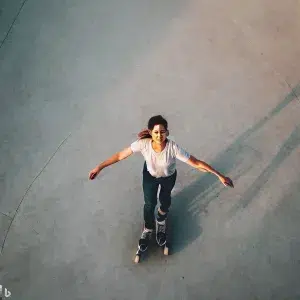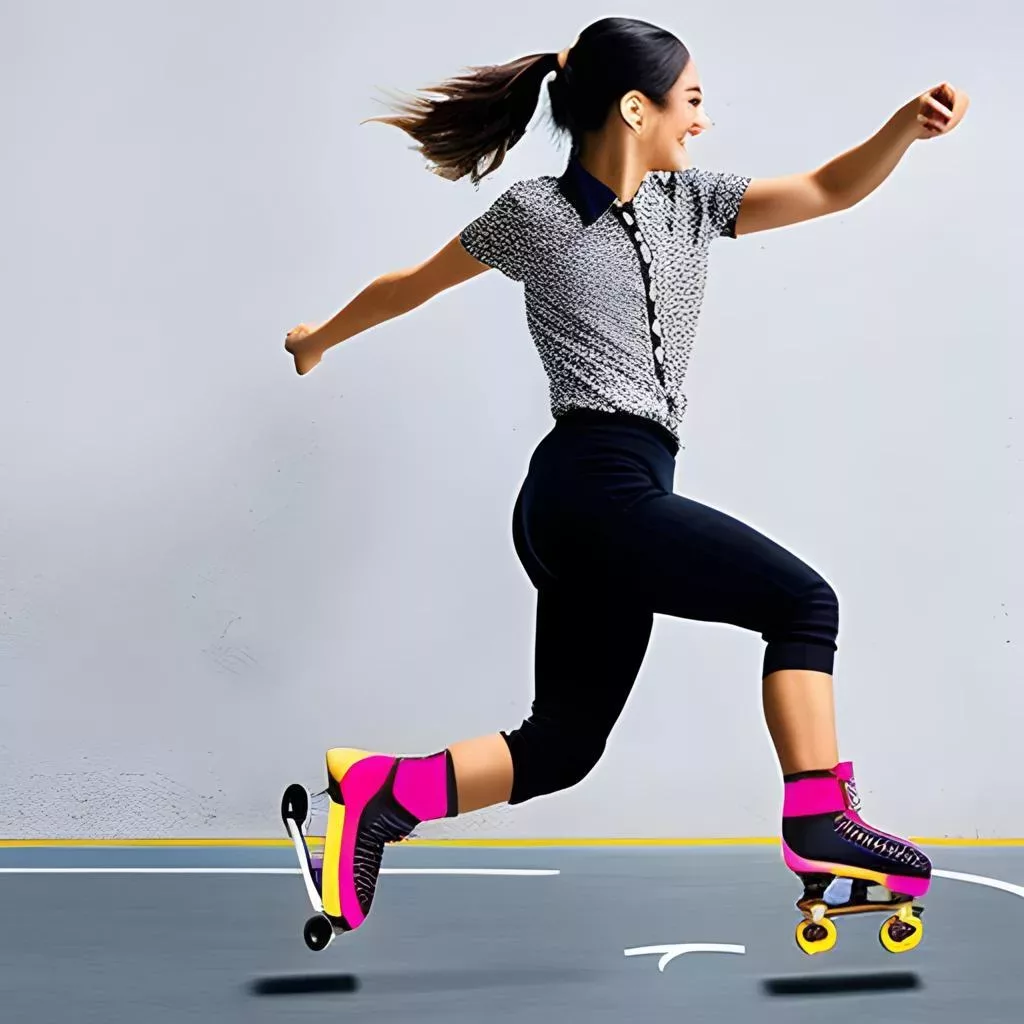Table of Contents
If you’re new to skating, learning how to turn on quad skates can be a bit intimidating. But with practice and patience, you can master the skill and feel more confident on your skates. In this article, we’ll provide tips and tricks for turning on quad skates, specifically for beginners.
First, it’s important to understand the mechanics of turning on quad skates. Unlike inline skates, quad skates have a wider base and four wheels, which can make turning feel different.
The key to turning is shifting your weight and using your edges to guide your movement. It’s also important to have proper posture and balance, which will help you maintain control as you turn.
In the following sections, we’ll provide step-by-step instructions for turning on quad skates, as well as common mistakes to avoid. Whether you’re interested in recreational skating or want to try your hand at roller derby, mastering this skill will help you feel more comfortable and confident on your skates.
Key Takeaways: How to Turn on Quad Skates for Beginners
Turning on quad skates is a fundamental skill that, while initially challenging for beginners, can be mastered with practice, patience, and the right approach. Here are the key takeaways from the article “How to Turn on Quad Skates for Beginners: Top Tips and Tricks”:
- Understanding Quad Skates Mechanics: Turning on quad skates involves shifting your weight and using the edges of your skates. Proper posture and balance are crucial for maintaining control during turns.
- Choosing and Fitting Skates: Selecting the right type and size of quad skates is essential. Fit your skates with the same socks you plan to skate in, ensuring your heel is snug and your toes can wiggle freely.
- Preparing to Turn: Before attempting turns, ensure you are comfortable standing and balancing on your skates. Practice shifting your weight from one foot to the other and balancing on one foot at a time.
- Basic Turning Techniques: Master basic turns by shifting your weight to the inside foot of the turn, keeping your knees slightly bent, and using your arms for balance. Practice turning in both directions to improve balance and coordination.
- Practicing Turns: Begin practicing on a flat, smooth surface. Start with small, slow turns, gradually increasing speed and the size of your turns as you gain confidence. Use a railing or wall for support if needed.
- Safety and Patience: Always wear protective gear and practice in a safe environment. Don’t rush the learning process. Good balance and control are necessary before moving on to advanced maneuvers.
- Continuous Practice: Turning effectively on quad skates comes with time and practice. Focus on maintaining a good posture, smooth weight shifting, and starting with smaller turns before attempting larger ones or increasing speed.
JeeFree Adjustable Color Gradient Skateboard Helmet for 3-5-8-14+Ages【Toddler Kids Youth Adult】 Girls Boys Woman.Bike Helmet for Multi-Sports Cycling Bicycle Scooter Inline Roller Skate Rollerblading
(as of 07/25/2024 14:17 GMT +01:00 - More infoProduct prices and availability are accurate as of the date/time indicated and are subject to change. Any price and availability information displayed on [relevant Amazon Site(s), as applicable] at the time of purchase will apply to the purchase of this product.)Choosing the Right Quad Skates
Fitting Quad Skates
Fitting quad skates is an essential step in ensuring a comfortable and safe skating experience. When selecting skates, make sure to measure your foot size accurately and use the manufacturer’s size chart to determine the appropriate size. It’s important to note that different brands may have slightly different sizing, so it’s always best to refer to the specific brand’s size chart.
When trying on skates, make sure to wear the same socks you plan to wear while skating. Your toes should be able to wiggle freely, but your heel should be snugly in place.
Make sure the tongue of the skate is centred over your foot and that the laces are tight enough to provide support but not so tight that they cut off circulation.
If you have any concerns about the fit of your skates, consider seeking advice from a professional skate fitter.
Quad Skate Types
Quad skates come in various types, each with its own unique features and benefits. Beginners may want to consider a basic recreational quad skate, which is designed for indoor and outdoor use and provides a stable base for learning the basics of skating.
For those interested in more advanced skating, there are speed skates, artistic skates, and roller derby skates, each with specific features tailored to the demands of the activity. It’s important to choose a skate that is appropriate for your skill level and skating goals.
Adult Knee Pads Elbow Pads Wrist Guards for Adult Kids 6 in 1 Protective Gear Set for Skateboarding Biking Roller Skating Cycling Outdoor Sports Black L
(as of 07/25/2024 14:17 GMT +01:00 - More infoProduct prices and availability are accurate as of the date/time indicated and are subject to change. Any price and availability information displayed on [relevant Amazon Site(s), as applicable] at the time of purchase will apply to the purchase of this product.)Quad Skate Components
Quad skates consist of several components, including the boot, plate, wheels, bearings, and toe stop. Each of these components plays a critical role in the performance and comfort of the skate.
The boot is part of the skate that covers the foot and ankle and provides support. The plate is the metal frame that holds the wheels and attaches to the boot.
The wheels are made of various materials and come in different sizes and hardness levels, depending on the intended use.
Bearings are small metal balls that allow the wheels to spin freely.
The toe stop is a rubber brake located at the front of the skate that allows the skater to slow down or stop.
When choosing quad skates, consider the quality and durability of each component and how they will affect your skating experience.
Preparing to Turn on Quad Skates
Standing on Quad Skates
Before attempting to turn on your quad skates, it is important to make sure you are standing correctly.
Start by placing your feet shoulder-width apart and parallel to each other. Your knees should be slightly bent, and your weight should be evenly distributed on both feet.
Make sure your toes are pointing straight ahead and your heels are touching the ground.
If you are new to quad skating, it may be helpful to practice standing in this position for a few minutes to get used to the feeling of being on skates. Once you feel comfortable, you can move on to practising your balance.
Kuxuan Skates Adjustable Inline Skates for Kids and Youth with Full Light Up Wheels Camo Outdoor Fun Illuminating Skates for Girls and Boys Beginner
(as of 07/25/2024 14:17 GMT +01:00 - More infoProduct prices and availability are accurate as of the date/time indicated and are subject to change. Any price and availability information displayed on [relevant Amazon Site(s), as applicable] at the time of purchase will apply to the purchase of this product.)Balancing on Quad Skates

Good balance is key to successfully turning on quad skates. To practice your balance, start by shifting your weight from one foot to the other. Keep your knees slightly bent and your core engaged to help maintain your balance.
Once you feel comfortable shifting your weight from side to side, try lifting one foot off the ground and balancing on the other foot. Hold this position for a few seconds before switching to the other foot. Repeat this exercise several times until you feel confident in your ability to balance on one foot.
Another helpful exercise is to practice gliding on one foot. Start by pushing off with one foot and lifting the other foot off the ground. Glide forward on one foot for a few seconds before switching to the other foot. This will help you get used to the feeling of turning on one foot and will improve your overall balance on quad skates.
Turning on Quad Skates
If you’re new to roller skating, turning can be a bit intimidating at first. However, with practice and the right technique, turning on quad skates can be a breeze. In this section, we’ll cover the basic turn and the parallel turn, two essential techniques for any beginner roller skater.
Basic Turn on Quad Skates
Tips and Tricks for Turning on Quad Skates
Maintaining Balance While Turning
Turning on quad skates can be tricky for beginners. One of the most important things to keep in mind is maintaining balance while turning. To do this, make sure you have a strong, stable stance with your feet shoulder-width apart. Keep your knees slightly bent and your weight evenly distributed on both feet.
As you begin to turn, shift your weight onto the foot that is on the inside of the turn. This will help you maintain your balance and control your speed. Keep your arms out to the sides to help you balance and use your core muscles to keep your body stable.
Nattork Kids Roller Skates for Boys Girls Kids, 4 Sizes Adjustable Quad Skates with All Light up Wheels - Birthday Gift for Indoor Outdoor Sports
(as of 07/25/2024 14:17 GMT +01:00 - More infoProduct prices and availability are accurate as of the date/time indicated and are subject to change. Any price and availability information displayed on [relevant Amazon Site(s), as applicable] at the time of purchase will apply to the purchase of this product.)Practising Turning on Quad Skates

Practice makes perfect when it comes to turning on quad skates. Start by practising on a flat, smooth surface with plenty of room to move around. Begin by making small, slow turns and gradually increase your speed and the size of your turns as you gain confidence.
It’s also helpful to practice turning in both directions to improve your balance and coordination. Try to focus on keeping your movements smooth and fluid, and avoid making sudden, jerky movements that can throw off your balance.
Another helpful tip is to practice turning while holding onto a railing or wall for support. This can help you feel more secure and confident as you work on improving your turning skills.
Conclusion
Learning how to turn on quad skates can be challenging for beginners, but with practice and patience, it can be mastered. Remember to always prioritize safety by wearing protective gear and skating in a safe environment.
Start by practising basic turns, such as the forward turn and the backward turn, before moving on to more advanced techniques. Keep your body weight centred over your skates and use your edges to control your movements.
It’s important to develop good balance and control before attempting any tricks or advanced manoeuvres. Take your time and don’t get discouraged if it takes a while to get the hang of it.
By following these tips and tricks, you’ll be well on your way to becoming a confident and skilled quad skater. So grab your skates, hit the rink, and have fun!





